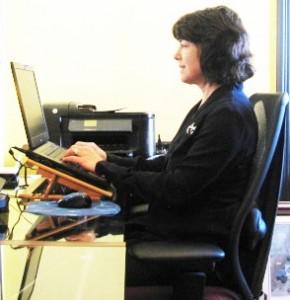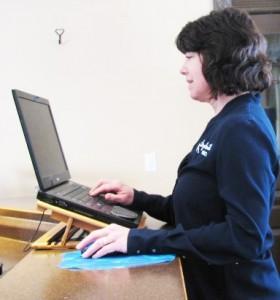In the media, I’ve seen “pushback” on standing workstations, claiming that “prolonged standing” is no better than prolonged sitting. I agree that prolonged standing can have harmful effects, although I would not say that it is worse than prolonged sitting. Further, I do not believe that the widely promoted “sit-stand stations” were meant to promote “prolonged” standing. I suspect that these warnings against the promotion of standing are an effort to protect the status quo, perhaps to avoid spending money, or to avoid change. Here is my reasoning for promoting sit/stand options, where possible:
- In the 80’s we learned that sitting creates 40-90% more pressure on the discs than standing. (Nachemson, 1981 If you google search “disc pressure chart” you’ll find dozens of representations of Nachemson’s research.) It has been promoted that standing positions the vertebrae so that each disc has equal pressure front to back, resulting in less strain, particularly on the lower back. More recent research has suggested that sitting upright may not be as bad as we thought, but slouching, leaning, or bending forward, whether sitting or standing, does increase disc pressure.
- Standing reduces forward reaching, and should not only alleviate back discomfort, but may also help with shoulder discomfort. Prove it to yourself:

- Sit at your desk and look down. Is there any space between your belly and the desk? (Likely yes). Are your elbows resting against the side of your body, in line with the side seam of your shirt as you type or mouse? (Often not.) Reaching forward to type, to mouse, or to complete paperwork on your desk results in a higher demand on your shoulders.
- Now stand at a table that is approximately elbow
 height, if possible. (If you are about Karen’s height, propping the laptop on a stand or empty binder, on top of the kitchen counter, works well.) Look down again. Is there any space between your belly and your desk? Likely not. We tend to stand right up to a standing desk, whereas we sit further back, often because the armrests of our chair keep us back. Standing allows you to work with the elbows at your sides, and so the load on your shoulders is minimal. (Note the position of Karen’s elbow in the standing photo – her upper arm is hanging, relaxed, at the side of her body. It hard to see in the sitting photo, but trust us that she is reaching further.)
height, if possible. (If you are about Karen’s height, propping the laptop on a stand or empty binder, on top of the kitchen counter, works well.) Look down again. Is there any space between your belly and your desk? Likely not. We tend to stand right up to a standing desk, whereas we sit further back, often because the armrests of our chair keep us back. Standing allows you to work with the elbows at your sides, and so the load on your shoulders is minimal. (Note the position of Karen’s elbow in the standing photo – her upper arm is hanging, relaxed, at the side of her body. It hard to see in the sitting photo, but trust us that she is reaching further.)
- Moving is healthy. (I think we all agree on that.) Prolonged use of any muscle group will lead to fatigue and discomfort. Standing makes it easier to move around. If I’m sitting in my chair, I will wait until I’ve got a really good reason to get up. But when I’m standing, it’s no trouble to fetch something from the printer, deliver a message in person, or toss something into the recycling bin. I’ll even take a step or two to answer the phone or grab a pen. I’m more likely to move. Here are my Fitbit® stats – not a scientific study, but I was curious. For one hour I stood at my desk; my Fitbit® reported 83 steps (including one trip to the printer). For the next hour, I mostly sat, and my Fitbit® reported 73 steps (also including one trip to the printer). The difference between sitting and standing amounted to only 10 steps per hour; I was disappointed. However, I later confirmed that the device doesn’t register steps when I side-step to reach for for my phone or to grab a sheet of paper, so think I was more mobile while standing, even if I couldn’t demonstrate a big difference. I always feel better when I’ve been standing periodically during the day. A very recent paper (Zemp et al., 2016 http://www.sciencedirect.com/science/article/pii/S0003687016300515 ) showed that people with back pain tended to move less, in their chairs, than people without back pain. (Chicken and egg?) Perhaps if we act like people without back pain, we might end up like them! They felt that reminders to move periodically might help to prevent back pain amongst seated workers.
- Ergonomists have not been saying, “Get rid of your chair! Stand all day!” Sit/stand stations are intended to promote changes in posture during the day. Stand until you’re tired and then sit for a while, alternating between the two positions often over the course of your day. You might find that you prefer to sit down for some tasks and stand for others. For example, I find that I like to read my screen, or draft text (such as this one) while I’m standing. If I have to mark up a paper document, or do something that involves heavy-duty concentration, then I do prefer to sit. I’m quite happy to stand for at least half of my day, if I choose my footwear properly.
- When I forget to sit (which happens occasionally), then my legs are a bit tired at the end of the day, but that is the extent of it. Note that most factory workers stand all day, all the time. Yes, some of them report discomfort in their legs or back, particularly if they stand still, or on concrete. (I’d say, in the past two decades, safety footwear has come a long way toward improved standing comfort.) In our anecdotal experience, we hear more complaints about leg and back pain from office workers who can’t or won’t leave their chairs for prolonged periods of time.
We’ve been saying this for a long time: Move it! Research may not be able to determine the “best” working posture for office work; should we sit upright, forward, or reclined, or is standing better? If standing is better, should we have a mat, a footrest, a leaning stool? Perhaps the reason we can’t identify an optimum posture is that there is no one posture that we can safely maintain all day. There seems to be little argument that moving around, and changing posture throughout the day, is good for you. So, if you’re sitting as you read this, please get up and move about for a few minutes!
If you need some help introducing sit/stand options in your workplace, please contact us. Where budget, space, and logistics allow, we suggest providing some “standing landing” stations, where employees can sign in and try standing for an hour or so each day. We can help you to facilitate this change with employee ergo workshops, posters, awareness materials, ergonomist support for “ergo fairs”, etc.

